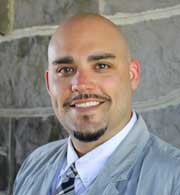Soaring Cost of Cancer Care Prompts New Research and Dialogue
Stories - Jun 29 2018
 By Jill Pope, Senior Technical Writer & Editor
By Jill Pope, Senior Technical Writer & Editor
Health systems are under significant pressure to improve patient outcomes while also controlling costs.
For many people diagnosed with cancer, there is more reason for optimism than ever before. New technologies, discoveries in genetics and genomics, and novel drug therapies are empowering patients in a way that wasn’t possible for previous generations.
 Matthew P. Banegas, PhD, MPH
Matthew P. Banegas, PhD, MPH
But there’s a catch: cancer treatment often comes at an exorbitant cost, presenting a serious challenge to health systems, patients, and their families.
This conflict between state-of-the-art treatment and affordability drives the research agenda of Matthew P. Banegas, PhD, MPH, an investigator at the Kaiser Permanente Center of Health Research (CHR) in Portland, Oregon. Dr. Banegas has been studying cancer costs since graduate school. Before he joined CHR, he worked at the National Cancer Institute, where he helped develop research resources to reduce the economic burden of cancer in the U.S. He also conducted research on serious financial hardships among working-age cancer survivors in the U.S., particularly medical debt and bankruptcy.
Banegas stresses that patients with cancer today—even those with health insurance—face extremely high costs for their care. According to the American Society of Clinical Oncology, newly approved cancer drugs cost an average of $10,000 per month, with some costing more than $30,000 per month.
“Most new cancer drug regimens cost at least $100,000 per year,” Banegas says. “And we are also seeing a trend among health plans and insurers that is asking patients to share more of those costs. Unfortunately, the health insurance plans with the most affordable premiums often have the highest out-of-pocket costs for patients.”
New Study Offers Detailed Estimates of the Costs of Cancer Care
Knowing that health systems are under increasing pressure to improve the quality of cancer care while containing costs, Dr. Banegas and colleagues from the Cancer Research Network conducted a study to provide cost estimates to inform policy and practice in this critical area.
The study team used data on insured patients from four integrated health systems to estimate the medical care costs of the four most common cancers in the U.S.—breast cancer, lung cancer, colorectal cancer, and prostate cancer.
“We felt there was a major gap in the body of research on cancer care costs,” says Banegas. “Most of the current literature on cancer care costs is based on SEER Medicare data, which are limited to fee-for-service beneficiaries. But cancer is not just a disease of the aged—in fact, about one-half of cancer diagnoses in the U.S. occur among people under age 65. We felt it was important to improve our understanding of cancer costs for U.S. adults of all ages.”
Banegas and his co-authors estimated total and cancer-specific costs using data for more than 45,000 patients with cancer and a control group of more than 300,000 patients without cancer from four health plans: Group Health Cooperative (now Kaiser Permanente Washington), Henry Ford Health System, Kaiser Permanente Colorado, and Kaiser Permanente Northwest. The researchers combined tumor registry and electronic medical records data from the health systems to estimate costs by cancer site, stage at diagnosis, and age group.
To produce the estimates, the team used a costing algorithm previously developed by researchers at CHR. “This study rests on some really painstaking work done by Maureen O’Keeffe-Rosetti and Erin Keast,” says Banegas. “They developed a medical care costing algorithm that has enabled all of the cost analysis work we’ve done.”
The Study’s Main Findings:
- Cancer-specific costs were higher, across all cancer types, for patients under 65, compared with patients 65 and older.
- Costs for all types of cancer increased with advanced stage at diagnosis, highlighting the importance of early detection in limiting costs.
- Across all four types of cancer, costs were highest in the initial phase of care following diagnosis, and in the end-of-life phases.
- Average costs to treat lung cancer for one year ranged from $50,700 (stage 1) to $97,400 (stage IV) for patients under 65; $44,000 to $71,200 for patients 65 and older.
Two things about the study surprised Dr. Banegas: “First, the magnitude of the costs. It’s always shocking when you see several zeros. And these are just the average costs. Second, when we consider that these data are about ten years old and that costs have only gone up since then, we know that these cost estimates are actually quite conservative.”
Having good estimates of what it costs to care for people with cancer will help health systems allocate resources. “This study provides detailed information about costs of cancer at different stages, and it shows that later-stage cancers are much more costly to treat,” Banegas said. “So health plans can plug our estimates into their prediction tools, and see how much they might save by increasing their investment in prevention and early detection.”
Starting a Conversation About Value
Ultimately, Banegas’ goal is to give health systems and patients the information they need to make important—and often difficult—decisions.
“People have to start talking about the value of care,” he says. “I think a good way to do that is by asking, ‘What do providers, patients, and patients’ families all consider to be of value?’ For example, sometimes a high-cost drug might only extend someone’s life by two months. I want to get that information into the hands of providers and into the hands of patients and their families, so they can really consider, is getting that much more time worth the cost—which might be $10,000? Would the family rather use that money for other purposes? I want to provide the data that will help inform those discussions.”